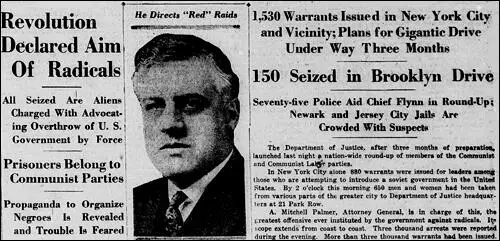The Palmer Raids
In 1919 Woodrow Wilson appointed A. Mitchell Palmer as his attorney general. Palmer recruited John Edgar Hoover as his special assistant and together they used the Espionage Act (1917) and the Sedition Act (1918) to launch a campaign against radicals and left-wing organizations.
Worried by the revolution that had taken place in Russia, Palmer became convinced that Communist agents were planning to overthrow the American government. His view was reinforced by the discovery of thirty-eight bombs sent to leading politicians and the Italian anarchist who blew himself up outside Palmer's Washington home. Palmer recruited John Edgar Hoover as his special assistant and together they used the Espionage Act (1917) and the Sedition Act (1918) to launch a campaign against radicals and left-wing organizations.
A. Mitchell Palmer claimed that Communist agents from Russia were planning to overthrow the American government. On 7th November, 1919, the second anniversary of the Russian Revolution, over 10,000 suspected communists and anarchists were arrested. Palmer and Hoover found no evidence of a proposed revolution but large number of these suspects were held without trial for a long time. The vast majority were eventually released but Emma Goldman and 247 other people, were deported to Russia..

On 2nd January, 1920, another 6,000 were arrested and held without trial. These raids took place in several cities and became known as the Palmer Raids. A. Mitchell Palmer and John Edgar Hoover found no evidence of a proposed revolution but large number of these suspects, many of them members of the Industrial Workers of the World (IWW), continued to be held without trial. When Palmer announced that the communist revolution was likely to take place on 1st May, mass panic took place. In New York, five elected Socialists were expelled from the legislature.
When the May revolution failed to materialize, attitudes towards Palmer began to change and he was criticised for disregarding people's basic civil liberties. Some of his opponents claimed that Palmer had devised this Red Scare to help him become the Democratic presidential candidate in 1920.
Primary Sources
(1) A. Mitchell Palmer, The Case Against the Reds (1920)
Behind, and underneath, my own determination to drive from our midst the agents of Bolshevism. I have discovered the hysterical methods of these revolutionary humans. I have been asked to what extent deportation will check radicalism in this country. Why not ask what will become of the United States Government if these alien radicals carry out the principles of the Communist Party?
In place of the United States Government we would have the horror and terrorism of Bolshevik tyranny such as the destroying Russia now. The whole purpose of communism appears to be the mass formation of the criminals of the world to overthrow the decencies of private life, to usurp property, to disrupt the present order of life regardless of health, sex or religious rights.
These are the revolutionary tenets of the Communist Internationale. These include the IWW's, the most radical socialists, the misguided anarchists, the agitators who oppose the limitations of unionism, the moral perverts and the hysterical neurasthenic women who abound in communism.
(2) Paul M. Buhle, A Dreamer's Paradise Lost (1995)
The Palmer Raids played a large intervening role. Escalating repression brought successive raids on all the known Communist headquarters. On the second day of 1920, federal and state agents made more than five thousand arrests, five hundred in California (a notable center of CLP strength) alone. Major leaders faced multiple indictments, and ordinary activists expected to be arrested at any time. In effect, the Communist movement was at best semilegal until the mid-1920s, when a general abandonment of prosecution surprised many who had anticipated living out long sentences or entering and reentering jail and exile much of the rest of their lives.

